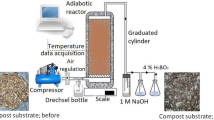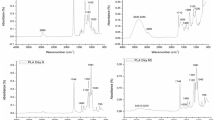Abstract
The rigid foils obtained from polylactide (PLA) with synthetic poly[(R,S)-3-hydroxybutyrate] ((R,S)-PHB) can be used for production of food packages, which is important enhancement of biodegradable materials application. The biodegradable rigid packaging can be subjected to organic recycling together with food remains. The degradation of PLA and its blend with (R,S)-PHB as rigid foils were studied under industrial composting conditions. Incubation of these materials in water at 70 °C (hydrolytic degradation) was conducted as reference experiment. Gel permeation chromatography, electrospray mass spectrometry, nuclear magnetic resonance and differential scanning calorimetry were used to determine the progress of degradation during incubation in selected environments. The present results showed that PLA-based rigid foil degrades under industrial composting conditions. In the blends, (R,S)-PHB content was found to accelerate the degradation process under industrial composting conditions in comparison with the reference experiment. Thus, it is possible to control the degradation process by changing the composition of polymer blend.








Similar content being viewed by others
References
Choubisa B, Patel M, Dholakiya B (2013) Synthesis and characterization of polylactic acid (PLA) using a solid acid catalyst system in the polycondensation method. Res Chem Intermed 39:3063–3070
Guan Q, Naguib HE (2014) Fabrication and characterization of PLA/PHBV-chitin nanocomposites and their foams. J Polym Environ 22:119–130
Bartczak Z, Galeski A, Kowalczuk M, Sobota M, Malinowski R (2013) Tough blends of poly(lactide) and amorphous poly([R,S]-3-hydroxy butyrate)—morphology and properties. Eur Polym J 49:3630–3641
Garlotta D (2001) A literature review of poly(lactic acid). J Polym Environ 9:63–84
Rasal RM, Janorkar AV, Hirt DE (2010) Poly(lactic acid) modifications. Prog Polym Sci 35:338–356
Sudesh K, Iwata T (2008) Sustainability of biobased and biodegradable plastics. Clean Soil Air Water 36:433–442
Arias V, Höglund A, Odelius K, Albertsson A-C (2014) Tuning the degradation profiles of poly(l-lactide)-based materials through miscibility. Biomacromolecules 15:391–402
Ren J (2010) Biodegradable poly(lactic acid): synthesis, modification, processing and applications. Springer, Berlin
Gandini A (2008) Polymers from renewable resources: a challenge for the future of macromolecular materials. Macromolecules 41:9491–9504
Koller M, SalernoA Dias M, Reiterer A, Braunegg G (2010) Modern biotechnological polymer synthesis: a review. Food Technol Biotechnol 48:255–269
Rutkowska M, Krasowska K, Heimowska A, Adamus G, Sobota M, Musioł M, Janeczek H, Sikorska W, Krzan A, Zagar E, Kowalczuk M (2008) Environmental degradation of blends of atactic poly[(R,S)-3-hydroxybutyrate] with natural PHBV in Baltic Sea water and compost with activated sludge. J Polym Environ 16:183–191
Rydz J, Wolna-Stypka K, Adamus G, Janeczek H, Musioł M, Sobota M, Marcinkowski A, Krzan A, Kowalczuk M (2015) Forensic engineering of advanced polymeric materials. Part 1—degradation studies of polylactide blends with atactic poly[(R,S)-3-hydroxybutyrate] in paraffin. Chem Biochem Eng Quart 29:247–259
Dong W, Ma P, Wang S, Chen M, Cai X, Zhang Y (2013) Effect of partial crosslinking on morphology and properties of the poly(β-hydroxybutyrate)/poly(d, l-lactic acid) blends. Polym Degrad Stab 98:1549–1555
Musioł M, Janeczek H, Jurczyk S, Kwiecień I, Sobota M, Marcinkowski A, Rydz J (2015) (Bio)degradation studies of degradable polymer composites with jute in different environments. Fiber Polym 16:1362–1369
Rydz J, Sikorska W, Kyulavska M, Christova D (2015) Polyester-based (bio)degradable polymers as environmentally friendly materials for sustainable development. Int J Mol Sci 16:564–596
Scandola M, Focarete ML, Adamus G, Sikorska W, Baranowska I, Świerczek S, Gnatowski M (1997) Polymer blends of natural poly(3-hydroxybutyrate-co-3-hydroxyvalerate) and synthetic atactic poly(3-hydroxybutyrate). Characterization and biodegradation studies, crystallinity-induced biodegradation of novel [(R,S)-b-butyrolaktone]-b-pivalolactone copolymers. Macromolecules 30:2568–2574
Scandola M, Focarte L, Gazzano M, Matuszowicz A, Sikorska W, Adamus G, Kurcok P, Kowalczuk M, Jedliński Z (1997) Crystallinity-induced biodegradation of novel [(R,S)-β-butyrolactone]-b-pivalolactone copolymers. Macromolecules 30:7743–7748
Kawalec M, Adamus G, Kurcok P, Kowalczuk M (2007) Synthesis of poly[(R,S)-3-hydroxybutyrate-block-ethylene glycol-block-(R,S)-3-hydroxybutyrate]. Macromol Symp 253:59–64
Adamus G, Sikorska W, Janeczek H, Kwiecień M, Sobota M, Kowalczuk M (2012) Novel block copolymers of atactic PHB with natural PHA for cardiovascular engineering: synthesis and characterization. Eur Polym J 48:621–631
Kikkawa Y, Suzuki T, Tsuge T, Kanesato M, Doi Y, Abe H (2006) Phase structure and enzymatic degradation of poly(l-lactide)/atactic poly(3-hydroxybutyrate) blends: an atomic force microscopy study. Biomacromolecules 7:1921–1928
EN 13432:2000: Packaging. Requirements for packaging recoverable through composting and biodegradation. Test scheme and evaluation criteria for the final acceptance of packaging
Żakowska H (2012) Packaging waste recycling systems-selected legal, organizational and economical problems in Poland. Polimery 9:613–619
Avella M, Bonadies E, Martuscelli E, Rimedio R (2001) European current standardization for plastic packaging recoverable through composting and biodegradation. Polym Test 20:517–521
Krzan A, Hemjinda S, Miertus S, Corti A, Chiellini E (2006) Standardization and certification in the area of environmentally degradable plastics. Polym Degrad Stab 91:2819–2833
Davis G (2003) Characterizarion and characteristics of degradable polymer sacks. Mat Charact 51:147–157
Degli-Innocenti F, Bellia G, Tosin M, Kapanen A, Itavaara M (2001) Detection of toxicity released by biodegradable plastics after composting in activated vermiculite. Polym Degrad Stab 73:101–106
Witt U, Einig T, Yamamoto M, Kleeberg I, Deckwer WD, Muller RJ (2001) Biodegradation of aliphatic–aromatic copolyesters: evaluation of the final biodegradability and ecotoxicological impact of degradation intermediates. Chemosphere 44:289–299
Rychter P, Biczak R, Herman B, Smyłła A, Kurcok P, Adamus G, Kowalczuk M (2006) Environmental degradation of polyester blends containing atactic poly(3-hydroxybutyrate). Biodegradation in soil and ecotoxicological impact. Biomacromolecules 7:3125–3131
Rychter P, Kawalec M, Sobota M, Kurcok P, Kowalczuk M (2010) Study of aliphatic–aromatic copolyester degradation in sandy soil and its ecotoxicological impact. Biomacromolecules 11:839–847
Rychter P, Biczak R, Herman B, Zawierucha I, Musioł M, Sobota M, Kowalczuk M (2011) Environmental degradation of aromatic–aliphatic polyester blends. Evaluation of degradation products in soil and their phytotoxicological impact. Pol J Environ Stud 20:293–298
Żenkiewicz M, Richert A, Malinowski R, Moraczewski K (2013) A comparative analysis of mass losses of some aliphatic polyesters upon enzymatic degradation. Polym Test 32:209–214
Sikorska W, Richert J, Rydz J, Musioł M, Adamus G, Janeczek H, Kowalczuk M (2012) Degradability studies of poly(l-lactide) after multi-reprocessing experiments in extruder. Polym Degrad Stab 97:1891–1897
Sikorska W, Dacko P, Sobota M, Rydz J, Musioł M, Kowalczuk M (2008) Degradation study of polymers from renewable resources and their blends in industrial composting pile. Macromol Symp 272:132–135
Adamus G, Dacko P, Musioł M, Sikorska W, Sobota M, Biczak R, Herman B, Rychter P, Krasowska K, Rutkowska M, Kowalczuk M (2006) Degradation studies of selected synthetic polyesters at the natural condition. Polimery 51:539–546
Musioł M, Rydz J, Sikorska W, Rychter P, Kowalczuk M (2011) A preliminary study of the degradation of selected commercial packaging materials in compost and aqueous environments. Pol J Chem Technol 13:55–57
Cai H, Dave V, Cross R, McCarthy P (1996) Effects of physical aging, crystallinity, and orientation on the enzymatic degradation of poly(lactic acid). J Polym Sci Part B Polym Phys 34:2701–2708
Kobayashi S, Uyama H, Takamoto T (2000) Lipase-catalyzed degradation of polyesters in organic solvents. A new methodology of polymer recycling using enzyme as catalyst. Biomacromolecules 1:3–5
Sikorska W, Musiol M, Nowak B, Pajak J, Labuzek S, Kowalczuk M, Adamus G (2015) Degradability of polylactide and its blend with poly[(R,S)-3-hydroxybutyrate] in industrial composting and compost extract. Int Biodeterior Biodegrad 101:32–41
Silesian air monitoring. http://stacje.katowice.pios.gov.pl/monitoring. Accessed 22 Aug 2012
Rydz J, Adamus G, Wolna-Stypka K, Marcinkowski A, Misiurska-Marczak M, Kowalczuk M (2013) Degradation of polylactide in paraffin and selected protic media. Polym Degrad Stab 98:316–324
Andersson SR, Hakkarainen M, Inkinen S, Södergård A, Albertsson A-C (2010) Leads to higher hydrolytic stability but more acidic hydrolysis product pattern. Biomacromolecules 11:1067–1073
Cam D, Suong-Hyu H, Ikada Y (1995) Degradation of high molecular weight poly(l-lactide) in alkaline medium. Biomaterials 16:833–843
Rutkowska M, Krasowska K, Heimowska A, Kowalczuk M (2001) In: Chiellini E, Gil H, Braunegg G, Buchert J, Gatenholm P, van der Zee M (eds) Biorelated polymers: sustainable polymer science and technology. Kluwer Academic/Plenum Publishers, New York
Rydz J, Sikorska W, Musioł M, Janeczek H, Sobota M, Zawidlak-Węgrzyńska B, Kwiecień I, Kyulavska M, Koseva N, Christova D (2014) Degradation of PLA-based (nano)composites in different environments. In: Balabanova E, Mileva E (eds.) Nanostructured materials application and innovation transfer, Nanoscience & Nanotechnology, No 14. BPS Ltd, Sofia, Bulgaria, pp 109–111
Espartero JL, Rashkov I, Li SM, Manolova N, Vert M (1996) NMR analysis of low molecular weight poly(lactic acid)s. Macromolecules 29:3535–3539
Malinowski R, Żenkiewicz M, Richert S (2011) In: Wrobel G (ed) Polymers and constructional composites. Logos Press, Cieszyn (in Polish)
Di Lorenzo ML, Sajkiewicz P, Gradys A, La Pietra P (2009) Optimization of melting conditions for the analysis of crystallization kinetics of poly(3-hydroksybutyrate). e-Polym 27:1–12
Wang Y, Mano JF (2005) Influence of melting conditions on the thermal behavior of poly(l-lactic acid). Eur Polym J 41:2335–2342
Montserrat S, Colomer R (1984) The effect of the molecular weight on the glass transition temperature in amorphous poly(ethylene terephthalate). Polym Bull 12:173–180
Rydz J, Wolna-Stypka K, Musioł M, Szeluga U, Janeczek H, Kowalczuk M (2013) Further evidence of polylactide degradation in paraffin and in selected protic media. A thermal analysis of eroded polylactide foils. Polym Degrad Stab 98:1450–1457
Koyama N, Doi Y (1997) Miscibility of binary blends of poly[(R)-3-hydroxybutyric acid] and poly[(S)-lactic acid]. Polymer 38:1589–1593
Acknowledgments
The research was supported by the European Regional Development Fund, MARGEN Project No. POIG.01.03.01-00-018/08, by the European Commission under the Seventh Framework Programme, POLINNOVA Project No. 316086 and by the National Science Centre, NCN OPUS Project No. 2012/07/B/ST5/00627, (“Low pressure catalytic synthesis of novel beta-lactone monomers and their anionic ring-opening (co)polymerisation leading to synthetic analogues of aliphatic biopolyesters”), NCN SONATA Project No. 2012/05/D/ST5/03384. The outcomes of this research were used to implement the PLASTiCE project (3CE368P1, “Innovation value chain development for sustainable plastics in central Europe”, Central Europe Programme, co-financed by ERDF). The authors would like to thank R. Malinowski of the IMPIB in Toruń, Poland, for the preparation of PLA-based rigid films.
Author information
Authors and Affiliations
Corresponding author
Ethics declarations
Conflict of interest
The authors declare that they have no conflict of interests.
Compliance with ethics requirements
This article does not contain any studies with human or animal subjects.
Rights and permissions
About this article
Cite this article
Musioł, M., Sikorska, W., Adamus, G. et al. (Bio)degradable polymers as a potential material for food packaging: studies on the (bio)degradation process of PLA/(R,S)-PHB rigid foils under industrial composting conditions. Eur Food Res Technol 242, 815–823 (2016). https://doi.org/10.1007/s00217-015-2611-y
Received:
Revised:
Accepted:
Published:
Issue Date:
DOI: https://doi.org/10.1007/s00217-015-2611-y




